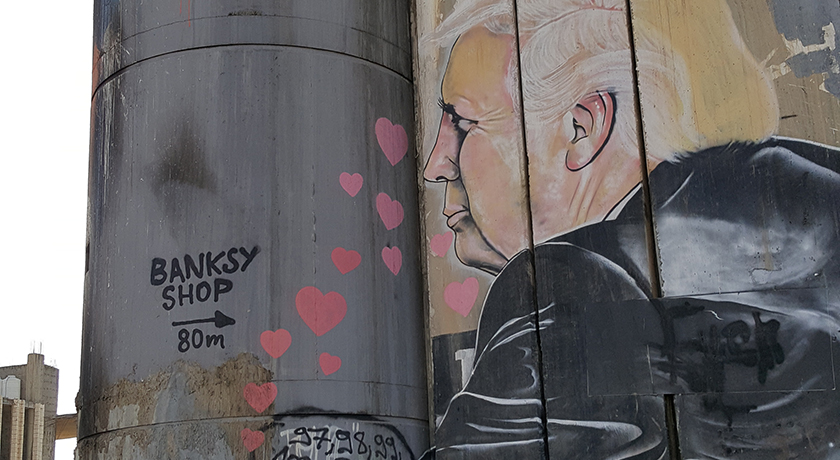 The Revd Philip Brooks, United Reformed Church Secretary of Ecumenical and Interfaith Relations, visited Israel last month and took part in an Israel-Palestinian task group to learn about and educate the denomination on issues affecting Israel and Palestine ahead of a denominational tour in 2019. He reflects on his trip in the wake of the controversial news that the United States moved its embassy to Jerusalem.
The Revd Philip Brooks, United Reformed Church Secretary of Ecumenical and Interfaith Relations, visited Israel last month and took part in an Israel-Palestinian task group to learn about and educate the denomination on issues affecting Israel and Palestine ahead of a denominational tour in 2019. He reflects on his trip in the wake of the controversial news that the United States moved its embassy to Jerusalem.
This week sees a small US consulate in Jerusalem become the focus of a global controversy. Situated in Arnona, a quiet neighbourhood in the south of Jerusalem, the consulate building, with fewer than 100 employees, will be transformed into the official US Embassy for Israel. Forty miles away, the former fortress-like embassy, and its 800-strong staff, will become the ‘Tel Aviv Branch Office’.
This symbolic move is the culmination of one of President Trump’s election campaign pledges and takes place today (14 May), commemorating the date on which Israel declared its independence in 1948. Tomorrow, Palestinians mark the ‘Nakba’, or the ‘catastrophe’, that befell them when they were displaced by Israel’s War of Independence.
Up until now, the international community have remained united in maintaining their embassies in Tel Aviv, given the contested status of Jerusalem. The United Nations voted 128 to nine (with 35 abstentions), in condemnation when the decision to move the US Embassy was announced. But, in contrast, Israel’s Prime Minister, Benjamin Netanyahu, lauded the US President as a ‘great friend’ and described the move as: ‘A great moment for the citizens of Israel and a historic moment for the state of Israel’. Clearly, the politics surrounding this issue have a long way to run as both religion and politics contribute to Jerusalem’s divisions.
My wife and I had the privilege of visiting Jerusalem for the first-time last month with two colleagues from the URC. Although we had been well briefed beforehand, we were still taken aback by the obvious separation that we witnessed. The physical layout of the Old City of Jerusalem highlights the religious divisions. The city is split into four quarters; Christian, Armenian, Muslim and Jewish, and each has their own distinct identity.
We went to the ‘Western’ or ‘Wailing Wall’ – which is the supporting wall of the huge platform upon which the Temple once stood – now the most sacred place of prayer for the Jewish people. Our small party had to separate at this point. As in many faith traditions, my wife was directed to the section of the wall set aside for women to pray and the rest of us went to the bigger area reserved for the men.
We then visited the Church of the Holy Sepulchre, considered to be the site of Jesus’ crucifixion, tomb and resurrection. The site is occupied by six separate Christian denominations drawn from historic Orthodox and Catholic traditions. As a first-time observer, it perhaps gives the appearance of churches competing for one holy space, but more accurately it represents an agreement which goes back over many generations.
Early on the Sunday morning we left our beds to join the 7.30 am queue to visit the Haram-esh-Sharif (Noble Sanctuary) within which stands the Dome of the Rock and the Al Aqsa Mosque. Access to this area, where the Temple once stood, is limited to specific times of the week for non-Muslims.
Not far away we paid a moving visit to the Garden of Gethsemane on the Mount of Olives. But even here, as I looked towards the Old City the view was dominated by separate burial areas, dividing Christian, Jews and Muslims even in death. Such division is not unique to Jerusalem, it just somehow felt more painfully apparent in this most holy of places.
Our pilgrimage included visits to Bethany and Bethlehem, which now involves going through the checkpoints in the huge separation barrier. We had the opportunity to talk to Palestinian Christians, who spoke of their real fears for the fragile balance of peace posed by the move of the US Embassy. These fears echoed the words of the Heads of Churches in Jerusalem who wrote to President Trump in December 2017 asking him to re-think his decision because: ‘Any sudden changes would cause irreparable harm’.
We left Jerusalem with many questions unanswered and a good degree of sadness. It prompted me to turn to the final section of Luke Chapter 13, entitled ‘Lament for Jerusalem’. Verse 34 records Jesus’ words: ‘Jerusalem, Jerusalem, the city that kills the prophets and stones those who are sent to it! How often have I desired to gather your children together as a hen gathers her brood under her wings, and you were not willing!’
Let us hope and pray that the events of this week do not turn into yet another lament for Jerusalem. As people of God, may we continue to work for peace and justice for all in this very troubled part of the world, which draws together people from so many different traditions of faith. May we hold onto the hope of Psalm 133: ‘How good it is, how pleasant for God’s people to live in unity’.
Credit: The graffitied separation barrier, Philip Brooks.




